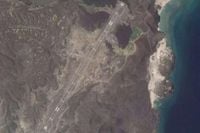Satellite images have revealed the rapid construction of a new airstrip on Zuqar Island, a volcanic outcrop in the Red Sea off Yemen’s coast, in a development that’s stirring speculation and concern among regional experts and shipping interests. The nearly 2,000-meter runway, first detected in images from April 2025, is the latest in a growing web of offshore bases in a region that has become a flashpoint for international maritime security.
Zuqar Island lies about 90 kilometers southeast of the Houthi-held port city of Hodeida, a vital shipping hub along the Red Sea corridor. According to analysis by Planet Labs PBC and reporting from The Associated Press, construction on the island began in earnest this past spring, starting with a new dock and followed by extensive land clearing for the runway itself. By late August, asphalt had been laid across the strip, and by mid-October, fresh runway markings were visible. The pace and scale of the project have raised eyebrows, even as no government or group has publicly claimed responsibility for the construction.
The airstrip’s strategic value is hard to overstate. The Red Sea and the adjacent Bab el-Mandeb Strait serve as a critical artery for global trade, linking the Mediterranean with the Indian Ocean. The area has seen a dramatic spike in violence since the outbreak of the Israel-Hamas war, with the Iranian-backed Houthi rebels launching more than 100 attacks on ships, sinking four vessels, and killing at least nine mariners, according to The Associated Press and Israel Hayom. The new base could allow anti-Houthi forces to step up aerial surveillance across the Red Sea, the Gulf of Aden, and the narrow waterway separating East Africa from the Arabian Peninsula.
Despite the airstrip’s obvious military potential, its ultimate purpose remains officially unconfirmed. The United Arab Emirates (UAE), widely believed to be behind several similar projects in the region, has declined to comment. Nor have Yemen’s anti-Houthi factions, who remain riven by competing interests and have struggled to mount a unified front against the rebels—even after intense U.S. and Israeli bombing campaigns targeting Houthi positions.
Still, the circumstantial evidence pointing toward Emirati involvement is strong. Ship-tracking data analyzed by AP shows a Togolese-flagged bulk carrier, the Batsa (also referred to as Albatssa in some reports), spent nearly a week docked at the new pier on Zuqar Island after arriving from Berbera, Somaliland—a port managed by DP World, a major UAE-based logistics company. While DP World declined to comment, Saif Shipping and Marine Services, another Dubai-based maritime firm, confirmed it had delivered asphalt to Zuqar, likely for the airstrip’s construction, on behalf of other UAE companies. This pattern fits with previous Emirati-linked projects elsewhere in Yemen, including runways in Mocha, Dhubab, Abd al-Kuri Island, and Mayun Island.
“The possibility of a new Yemeni offensive against the Houthis, backed by the Saudi-led coalition, can’t be ruled out, although I don’t see it as approaching,” said Eleonora Ardemagni, an analyst at the Italian Institute for International Political Studies, in comments cited by The Associated Press. “There’s a more important point in my view regarding the build up in Zuqar: the countering of Houthis’ smuggling activities, with particular regard to weapons.”
The timing of the airstrip’s construction aligns with a period of increased interdiction of cargo bound for the Houthis. Anti-Houthi forces have recently managed to seize several weapons shipments allegedly destined for the rebels, a feat that could be further enabled by a permanent presence on Zuqar Island. As Ardemagni noted, "A likely Emirati airstrip in Zuqar could serve to improve surveillance and monitoring off the Hodeida coast to better support Yemeni forces in tackling smuggling."
Zuqar Island’s strategic significance is not new. In 1995, Eritrea briefly seized the island after a clash with Yemeni forces, but an international court restored it to Yemen in 1998. The island was swept up in Yemen’s civil conflict after the Houthis seized the capital Sanaa in 2014 and advanced southward, including onto Zuqar. That push was halted in 2015 when Saudi Arabia and the UAE intervened on behalf of Yemen’s exiled government, retaking Zuqar and turning it into a staging ground for naval forces loyal to Tariq Saleh—a nephew of Yemen’s late strongman Ali Abdullah Saleh, and a figure who has received Emirati backing.
Since then, the front lines in Yemen have remained largely static, even as the conflict has spilled out to sea. The Houthis, for their part, have adapted by expanding their operations to target international shipping, drawing in the U.S. and Israel through retaliatory airstrikes. Despite these campaigns—such as the U.S.-led Operation Rough Rider—there has been little movement on the ground, and the anti-Houthi coalition remains a loose and fragmented alliance.
Gregory D. Johnsen, a noted Yemen expert, summed up the rebels’ resilience: “The Houthis, like any insurgent group, win by not losing. It is how the group has survived and grown from each of its wars.” This dynamic, he argues, has made it difficult for anti-Houthi forces to capitalize on their international support, even as they expand their military infrastructure across the region.
The UAE’s involvement in Yemen’s airstrip projects is no secret. In Mocha, an expanded airport now accommodates larger aircraft, a development credited to Emirati investment by local officials. The Southern Transitional Council, an anti-Houthi secessionist group with longstanding Emirati ties, controls Mayun Island and has openly acknowledged the UAE’s role in building its airport. Similar patterns have emerged in Dhubab and Abd al-Kuri Island, underscoring a broader strategy to establish a network of bases along vital shipping lanes.
Yet, as the Houthis continue their maritime campaign, the question remains: Will this new airstrip tip the balance in Yemen’s grinding conflict, or simply add another layer to the region’s tangled web of alliances and hostilities? For now, the runway on Zuqar Island stands as a stark reminder of the Red Sea’s enduring importance—and the lengths to which regional powers will go to secure it.
With the war in Yemen showing little sign of resolution, and the threat to international shipping ever-present, the world’s eyes will remain fixed on Zuqar Island and the shifting sands of power in the Red Sea.




